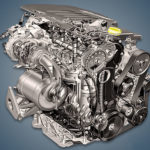The company assembled the 2.2-liter Renault G9T or 2.2 DCI diesel engine from 1999 to 2008 and installed it on top versions of its models such as Laguna, Vel Satis and Espace minivans. There was a derated version of this diesel engine for the Master minibus and its clones.
The G-series diesel line also includes: G8T and G9U.
In 1999, a 2.2-liter unit appeared on the Renault Master minibus of the second generation. It was one of the company’s first Common Rail diesels and it received a rather unusual timing: the crankshaft rotated the pump and injection pump using gears, one of which had a belt pulley that rotated the camshafts. The oil pump here was driven by a separate chain from the crankshaft. Also in the pallet of most modifications of this engine there was a block of balancer shafts.
Otherwise, it is a CR diesel with a Bosch CP1 or CP3 fuel system, depending on the version, a cast-iron block, a 16-valve head and a Garret GT1852V variable geometry turbine.
The engine was installed on:
- Renault Avantime 1 (D66) in 2002 – 2003;
- Renault Espace 3 (J66) in 2000 – 2002; Espace 4 (J81) in 2002 – 2007;
- Renault Laguna 2 (X74) in 2002 – 2007;
- Renault Master 2 (X70) in 1999 – 2006;
- Renault Vel Satis 1 (B73) in 2002 – 2008;
- Nissan Interstar 1 (T35) in 2002 – 2003; Interstar 2 (X70) in 2003 – 2005;
- Opel / Vauxhall Movano A (X70) in 1999 – 2006.
Specifications
| Production years | 1999-2008 |
| Displacement, cc | 2188 |
| Fuel system | Common Rail |
| Power output, hp | 115 – 150 90 (minibus version) |
| Torque output, Nm | 290 – 320 260 (minibus version) |
| Cylinder block | cast iron R4 |
| Block head | aluminum 16v |
| Cylinder bore, mm | 87 |
| Piston stroke, mm | 92 |
| Compression ratio | 18.0 17.8 (minibus version) |
| Hydraulic lifters | yes |
| Timing drive | combined |
| Turbocharging | Garret GT1852V |
| Recommended engine oil | 5W-30, 5W-40 |
| Engine oil capacity, liter | 7.2 |
| Fuel type | diesel |
| Euro standards | EURO 3/4 |
| Fuel consumption, L/100 km (for Renault Espace 2003) — city — highway — combined |
10.3 6.3 7.7 |
| Engine lifespan, km | ~300 000 |
| Weight, kg | 227 |
Disadvantages of the Renault G9T engine
- The combined timing drive has an unreliable mechanism for adjusting the gap between the gears in which the springs often burst. As a result, the gears grind off, and their fragments fall into the oil pan. It can also lead to bent valves.
- On runs over 100,000 km, the turbocharger shaft or its seals may wear out and the turbine will begin to drive lubricant into the intake. And this is fraught not only with a drop in the oil level, but also with its entry into the combustion chamber, from which the engine can simply go into overdrive.
- In addition to the turbine, the oil pump is often the culprit for the drop in the level of lubrication in the system. It not only wears out the shaft and gears, but also hangs the pressure reducing valve. Moreover, the oil pressure light usually lights up when the liners have already been turned.
- The most numerous calls to the service are associated with electrical failures, and the reason is usually a broken wiring. Also here very often the generator fails.
- This diesel engine is famous for regular oil leaks, and there are several weak points here. Most often, grease oozes from under the valve cover or through the timing gears.






